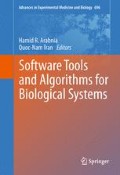Abstract
Computer simulations allow us to gain insight into biological systems that would not be possible without destroying or changing the system in significant ways. To ensure that results are relevant, real-world bio-data should be used to calibrate simulations. Real-world data contain uncertainty due to the nature of how it is obtained. This chapter provides various sources on uncertainty and methods to cope with this challenge.
Access this chapter
Tax calculation will be finalised at checkout
Purchases are for personal use only
References
Hazelrigg, G. A. (1999) On the Role and Use of Mathematical Models in Engineering Design. Journal of Mechanical Design. 121:336–342
McAllister, M. L., Dockery, J., Ovchinnikov, S., Adlassnig, K. (1985) Tutorial on Fuzzy Logic in simulation. Proceedings of the 1985 Winter Simulation Conference. In: Gantz, D., Blais, G., Solomon, S. (eds). 40–44
Cipra, B. (2000) Revealing Uncertainties in Computer Models. Science. New Series. 287:960–961
Sokolowski, J. A., Banks, C. M. (2009) Principles of Modeling and Simulation:A Multidisciplinary Approach. Wiley, New York
Oberkampf, W. L., Helton, J.C., Joslyn, C. A., Wojtkiewica, S. F., Ferson, S. (2004) Challenge Problems: Uncertainty in System Response Given Uncertain Parameters, Reliability Engineering System Safety. 85:11–19
Oren, T (2009) Modeling and Simulation: A comprehensive and Integrative View. In: Ylmaz, L., Oren, T. (eds) Agent-directed Simulation and Systems Engineering, Wiley, Germany, pp 3–36
Kelton, W. D. (2007) Representing and Generating Uncertainty Effectively. Proceedings of 2007 Winter Simulation Conference. In: Henderson, S.G., Biller, B., Hsieh, M. H., Shortle, J., Tew, J. D., Barton, R. R. (eds). 38–42
Oberkampf, W. L., DeLand, S. M., Rutherford, B. M., Diegert, K. V., Alvin, K. F. (2000) Estimation of Total Uncertainty in Modeling and Simulation, Sandia Report, SAND 2000-0824
Needham, C. J., Bradford, J. R., Bulpitt, A. J., Westhead, D. R. (2007) A Primer on Learning in Bayesian networks for Computational Biology, pLoS Computational Biology. 3(8):1409–1416
Raychaudhuri, S. (2008) Introduction to Monte Carlo Simulation, Proceedings of the 2008 Winter Simulation conference, In: Mason, S. J, Hill, R. R., Monch, L, Rose, O., Jefferson, T, Fowler, J. W. (eds)
Bartarseh, O. G., Wang, Y. (2008) Reliable Simulation with Input Uncertainties Using an Interval-based Approach. Proceedings of the 2008 Winter Simulation Conference
Costa, P. C. G. (2005) Bayesian Semantics for the Semantic Web. Doctoral Dissertation. Department of Systems Engineering and Operations Research, George mason University, Fairfax
Kühn, C., Wierling, C., Kühn, A., Klipp, E., Panopoulou, G., Lehrach, H., Poustka, A. J. (2009) Monte Carlo Analysis of an ODE Model of the Sea Urchin Endomesoderm Network. BMC Systems Biology. 1–18
Wang, J., Sijn W., Symmans, W. F., Pusztai, L., Coombes, K. R. (2009) The Bimodiality Index: A Criterion for Discovering and Ranking Bimodel Signatures from cancer Gene Expression Profiling Data cancer Informatics 7:199–216
Bayarri, M. J., Berger, J. O., Paulo, R., Sacks, J., Cafeo, J. A., Cavendish, J., Lin, C. H., Tu, J. (2005) A Framework for Validation of Computer Models. National Institute of Statistical Sciences. Technical Report 162
Cavendish, J. C. (2003) A Framework for Validation of Computer Models. In: Ferguson, D. R., Peters, T. J. (eds). Mathematics for Industry–Challenges and Frontiers. A Process View: Practice and Theory. Cambridge University Press
Lemey, P., Rambaut, A. D., Alexei J., Suchard, M. A. (2009) Bayesian Phylogeograph Finds Its Roots. Computational Biology. 5:9:1–16
Merrick, J. R. W., Dinesh, V., Singh, A., van Dorp, J. R., Mazzuchi, T. A. (2003) Propagation of Uncertainty in a Simulation-based Maritime Risk Assessment Model Utilizing Bayesian Simulation Techniques. Proceedings of the 2003 Winter Conference
Sheikh-Bahaei, S., Hunt, C. A. (2006) Prediction of InVitro Hepatic Biliary Excreation using Stochastic Agent-based Modeling and Fuzzy Clustering, Proceedings of the 2006 Winter Simulation conference, IEEE
Sanchez, S. M. (2008) Better than a PetaFlop: The Power of Efficient Experimental Design, Proceedings of the 2008 Winter Simulation conference. 73–84
Kuehl, R. O. (2000) Design of Experiments: Statistical Principles of Research Design and Analysis, 2nd edn, Brooks/Cole, Pacific Grove
Lehar, J., Zimmermann, G. R., Krueger, A. S., Molnar, R. A., Ledell, J. T., Heilbut, A. M., Hort, L. F. III, Giusti, L. C., Nolan, G. P., Magid, O. A., Lee, M. S., Borisy, A. A., Stockwell, B. R., Keith, C. T. (2007) Chemical Combination Effects Predict Connectivity in Biological Systems. Molecular Systems Biology. 3:80:1–13
Wu, C. F. J., Hamada, M. (2002) Experiments – Planning, Analysis, and Parameter Design Optimization. Wiley, New York
Leon, R. V., Shoemaker, A. C., Kacker, R. N.(1987) Performance Measures Independent of Adjustment an Explanation and extension of Taguchi’s Signal-to-Noise Ratios, Technometrics. 3:253–265
Rao, R. S., Kumar, C. G., Prakasham, R. S., Hobbs, P. J. (2008) The Taguchi Methodology as a Statistical Tool for Biotechnological Applications: A Critical Appraisal, Biotechnology Journal. 3:510–523
Darema, F. (2004) Dynamicd Data Driven Applications Systems; A New Paradigm for Application Simulation and Measurements. Computational Science. 4th International Conference. Krako, W. Poland, 3:662–669
Fikse, F. (2009) Fuzzy Classification of Phantom Parent Groups in Animal Model. Genetics Selection Evolution. 41:42
Author information
Authors and Affiliations
Corresponding author
Editor information
Editors and Affiliations
Rights and permissions
Copyright information
© 2011 Springer Science+Business Media, LLC
About this chapter
Cite this chapter
Blount, E.M., Ringleb, S.I., Tolk, A. (2011). Challenges When Using Real-World Bio-data to Calibrate Simulation Systems. In: Arabnia, H., Tran, QN. (eds) Software Tools and Algorithms for Biological Systems. Advances in Experimental Medicine and Biology, vol 696. Springer, New York, NY. https://doi.org/10.1007/978-1-4419-7046-6_72
Download citation
DOI: https://doi.org/10.1007/978-1-4419-7046-6_72
Published:
Publisher Name: Springer, New York, NY
Print ISBN: 978-1-4419-7045-9
Online ISBN: 978-1-4419-7046-6
eBook Packages: Biomedical and Life SciencesBiomedical and Life Sciences (R0)

